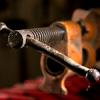
Originally Posted by
David Weaver

Derek, if an LN would've been double the cost, which is probably what it would've been vs. the far more efficient manufacturing of stanley, I seriously doubt many would've paid the difference in the 19th century.
David, everything is relative. You are assuming that a LN would have cost (relatively) twice a Stanley in the 19th century. Or that the Stanley would not cost (relatively) the same as the LN today. Anyway, this is not simply about cost (or relative cost); it is about quality. A good workman would have set his/her sights on the best tool available.
In terms of the rosewood, purchasing a quartered piece to make a knob (and then turning it) and purchasing a quartered or rift board big enough to make a handle is not trivial. LN's cocobolo handles and knobs were wonderful, but they eventually upcharged $50 for them (instead of the initial $25) and quit. The fact that a $300-$475 plane has cherry handles on it is a fairly big deal.
I don't understand what the issue is. Rosewood or Cocobolo or Cherry - the choice is yours ... at a price. It always costs. Either a manufacturer builds the cost in, or gives you the choice of an optional extra. Car manufacturers do this all the time.
The spring in a stanley cap iron does not make the plane more difficult to set up, it in fact gives a wider working range of the screw that retains the lever cap and gives the lever cap cam a much better feel. LVs don't use that cam, but the threaded screw that is used instead is less elegant and kind of cheapish appearing (partially because it's something that's associated with low-cost planes from the 50s. It's also associated with infill, but the screw on infills is pretty substantial and usually decorative to some extent. Both types of cap irons work, but there is nothing tricky about the stanley cap iron.
David, you have too many thoughts going at once. I'll try and answer each. Firstly, the Stanley chipbreaker's flex causes the leading edge to move when it is tightened/loosened. It has to be adjusted differently to the LN and LV, being solid. These are more predictable. Secondly, you introduce a cam, and thirdly you add a comment about appearance, and finally you comment about infills. I think that is more than the original issue.
Flex in an iron is no issue once one learns to use a cap iron properly. If it would have been an issue, stanley would've made their irons thicker. It *is* an issue in early single iron wooden planes, but steel was a substantial cost when they were made.
Flex is flex. Stanley irons flex. Flex causes chatter. LN and LV blades do not flex and (unless there is a loose screw or the blade is dull), they do not chatter. Not everyone knows how to use a chip breaker properly, nor wishes to do so - that is not a criticism of the chipbreaker, nor of those that use them, just a statement to ensure that the comparison is apples and apples ... plane and plane.
95% of the woodworking world is not hand planing abrasive woods, so wondersteel irons are a draw to amateurs more than they are a practical solution. If I were a pro, I would want to minimise down time. The "wondersteels" offer this advantage on all kinds of woods, not just the Australian abrasive variety. That said, mujingfang's irons last as long as anything and they're about ten bucks. You're off on a tangent again. I thought this was about supertuned Stanleys and LN/LV? I'd rather keep a plane aside with one of their irons for the very few times (planing cocobolo, maybe) that someone in the US would need the edge holding and have a carbon steel iron for everything else. For the same reason, there's no great reason to have heavy planes here, and I wouldn't want them as my normal planes. I did keep one heavy infill and it's nice to use sometimes - it's fun to bull it through wood, but if I was only to have one plane, I'd rather have a stanley 6 or a wooden fore plane than the infill. The infill is, however, less heavy than LN 8 that I used to have, and is probably similar in weight to the LN 7. My LN 7 was an excellent plane, but in the end, I don't use it for anything I couldn't use a millers falls 7 for - I'd call it a tossup, though. I much favor the LN 7 vs. the 8 for heavier work (planing edges would be no big deal, you don't do that much planing) because the 7 is much lighter. Anyway, we really don't have a practical place over here for 5 1/2 or 6 pound smoothers. Even the bedrock 4 1/2s, which are about 5 pounds, have a clunky overly heavy feel to them once you get used to a #4, but when you use the bedrock for a while, you don't go back to the 4 and think it's whiffy, rather that it's nimble. You sort of lost me a while back ...
(all of this, as you say, is perpsectives - but I seriously doubt a professional using planes would so quickly decide to spend much more on an LN plane - based on the old catalog prices for union and stanley planes, I'd guess that a lie nielsen would be at least 2 to 3 times as expensive as a comparable stanley. A stanley would've been a day's wage for a skilled worker around 1900, but productivity in the economy has made even inflation adjusted wages hard to compare because that still assumes that the % of income individuals had that was disposable would be the same, and that's not the case).
That is a value judgement, not a factual statement. I know plenty of pros that use LN and LV planes in their work today. Are they not doing the same work as their kin of yesteryear? They could choose cheaper tools? Some will, and some won't.
Regards from Perth
Derek




 Reply With Quote
Reply With Quote





 We all have attitudes about tools, it's just that our attitudes run the gamut from pretending we make rational choices to those who just say, "I want...." or "because I can". The hard part is admitting that no choice ever made is totally rational. All choices originate with a prejudice no matter how subtle.
We all have attitudes about tools, it's just that our attitudes run the gamut from pretending we make rational choices to those who just say, "I want...." or "because I can". The hard part is admitting that no choice ever made is totally rational. All choices originate with a prejudice no matter how subtle.
